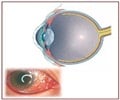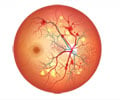The part of viral keratoconjunctivitis which causes pink eye has been isolated by researchers, thus making it possible to come up with a remedy for the problem in future.
The part of viral keratoconjunctivitis which causes pink eye has been isolated by researchers, thus making it possible to come up with a remedy for the problem in future.
Experts have been unsuccessful in finding out an effective treatment for the adenovirus infection that can force some individuals into isolation for up to two weeks.The virus is resilient and can remain infectious for up to 30 days on a plastic surface. Infection with the adenovirus causes inflammation, which results in red, irritated eyes, blurry vision and discharge.
Now, however, researchers in the Howe Laboratory, Department of Ophthalmology of the Massachusetts Eye and Ear Infirmary and Harvard Medical School, and in the University of Oklahoma Health Sciences Center, have new knowledge on the virus that causes pink eye.
James Chodosh, Eye and Ear cornea surgeon and senior author of the paper, said: "We were interested in understanding what part of the human adenovirus causes inflammation. We found that it is the protein coating around the virus that is most inflammatory in the eye.
"This is important because without inflammation, there would be no discharge from the eye, and therefore no transmission. Now that we know what causes the inflammation, we hope to find a way to block it."
The research team used a unique mouse model of adenovirus keratitis to study the role of viral components in the cornea and determine which viral part(s) induce an innate immune response.
Advertisement
Mice lacking the toll-like receptor 9 molecule, which acts as a pathogen DNA-sensing molecule within the cell, developed clinical inflammation upon adenovirus infection similar to wild type mice.
Advertisement
Chodosh concluded: "Our study provides new insights into how the innate immune system in the eye responds to a clinically important viral pathogen. With the new understanding, we are a step closer to developing a treatment for this common - and highly contagious - eye condition."
Source-ANI
RAS











